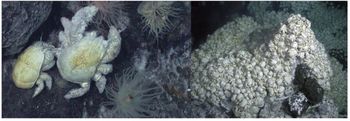Hydrothermal Vents: Black Smokers: Difference between revisions
| Line 27: | Line 27: | ||
[[Image: Hqdefault-5.jpg|thumb|300px|left|Collective of <i>Riftia Pachyptila</I> on a hydrothermal vent, picture retrieved from [https://www.youtube.com/watch?v=OT_VndRfCns].]] | [[Image: Hqdefault-5.jpg|thumb|300px|left|Collective of <i>Riftia Pachyptila</I> on a hydrothermal vent, picture retrieved from [https://www.youtube.com/watch?v=OT_VndRfCns].]] | ||
Another worm, <i>Alvinella Pompejana</i>, boasts the record of one of the most thermally resilient macro life forms on the planet, making its home right on the chimney walls. It achieves its thermal miracle with hair like projections that house epsilonproteobacteria who provide insulating, heat resisting services to the worm<ref name=a11>www.pnas.orgcgidoi10.1073pnas.0802782105</ref> | Another worm, <i>Alvinella Pompejana</i>, boasts the record of one of the most thermally resilient macro life forms on the planet, making its home right on the chimney walls. It achieves its thermal miracle with hair like projections that house epsilonproteobacteria who provide insulating, heat resisting services to the worm<ref name=a11>www.pnas.orgcgidoi10.1073pnas.0802782105</ref> | ||
[[Image: | [[Image: Tumblr lllvn7WobN1qeeqk5o1 400.jpg|thumb|200px|right|Example of <i>Alvinella pompejana</I>, known as a Pompeii Worm, and its distinctive hairs. Picture retrieved from [https://animalworld.tumblr.com/post/5906278173/pompeii-worm-alvinella-pompejana-and-the-microbe].]] | ||
. Finally, one other charismatic example of symbiosis comes from the Yeti Crab. Mobile enough to seek out optimal temperature gradients, these crabs also have hairs along their claws, which they wave around the vents and hydrothermal fluids of the black smokers. This motion helps stir up the rich quantities of methane and hydrogen sulfide solutes, that the chemoautotrophic bacteria then utilize in anaerobic oxidation<ref name=a12>http://www.bbc.com/earth/story/20170412-in-the-deep-sea-there-live-crabs-that-look-like-yetis</ref> | . Finally, one other charismatic example of symbiosis comes from the Yeti Crab. Mobile enough to seek out optimal temperature gradients, these crabs also have hairs along their claws, which they wave around the vents and hydrothermal fluids of the black smokers. This motion helps stir up the rich quantities of methane and hydrogen sulfide solutes, that the chemoautotrophic bacteria then utilize in anaerobic oxidation<ref name=a12>http://www.bbc.com/earth/story/20170412-in-the-deep-sea-there-live-crabs-that-look-like-yetis</ref> | ||
. <br> | . <br> | ||
Revision as of 23:50, 1 June 2020
Overview
[By Jonathan Murray]
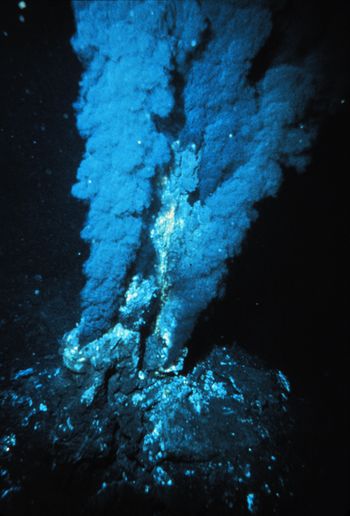
Nowhere is the resilience of life quite on display like it is near and on the Black Smokers. “Black Smokers” are hydrothermal vents found at sights of tectonic ridges and seafloor spreading, and spew jets of intensely hot chemically-laden fluids [1]. Devoid of light, scarce of oxygen, and crushed under intense pressure from the ocean above, such an environment appears uninhabitable to our standards. Nevertheless, a diverse group of microbes and microbes have managed to make black smokers their home, taking advantage of the heat, inorganic compounds, and even the radiation of the superheated rock to sustain themselves[2]. The microbes found at black smokers are known as “extremophiles” for the ability to thrive in places otherwise lethal to other forms of life, thanks in part to physiological processes and enzymes able to function under harsh conditions such as intense heat, known collectively as “extremozymes”[3]. These microbes form both the principal primary production of the environment through chemoautotrophy, and some forms of photoautotrophy, and are essential to the survival of several of the macro-organisms discovered at the black smokers[2]. In fact, the ability of these microbes to sustain life under such conditions have led many microbiologists to theorize that the ecology of black smokers may reflect some of the earliest stages of life on earth [4].
.
Environment of Black Smokers
The key to the formation of black smokers, and subsequently their surrounding ecology, is sea-floor spreading. When the tectonic plates of earth’s crusts are shifted, pulled, and moved thanks to the (modeled) convection currents of earth’s asthenosphere, at some boundaries between plates the crust diverges, allowing intensely hot magma to surge upward from below the earth’s surface. This forms a tectonic boundary known as a ridge[5]. At the ocean floor, these ridges are referred to as mid-ocean ridges, and when seawater enters the ridge and mixes with the super-heated magma, it produces a hydrothermal fluid which builds significant pressure until erupting off the ocean floor like an underwater gyre [6]. This hydrothermal fluid can be further cooled by the seawater, resulting in mineral deposition that forms the characteristic chimney-like structures of the black smokers. The vents which create black smokers tend to be hotter, anoxic, acidic and sulfurous [7], producing the characteristic black color and structures that can reach as high as 180 feet.
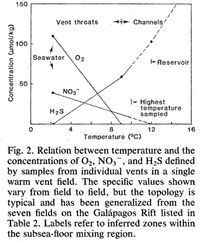
By contrast, the vents which produce the sibling of the black smokers, the white smokers, tend to have cooler plumes rich in barium, calcium, and silicon [5]. In general, the seafloor itself is devoid of sunlight and suffers from immense pressure. At the Juan de Fuca Ridge in the Pacific Ocean, the hydrothermal vents discovered there experience an equivalent pressure of 250 atmosphere, or as one author puts it, the same pressure as one would experience from an elephant standing on their big toe[9]
. The “extreme” of the black smokers also applies to their temperature gradients; the superheated fluids and rock of the vents surrounding by the serious cold of the deep ocean can range from near 0 to 400oC. With conditions like these, scientists assumed that no life could survive here until exploration of ridges in the late 1970s revealed hundreds of previously unknown species [5]. The microbes which make the black smokers their home are well adapted to use the heat, radiation, and anoxic chemical-laden fluids of the smokers to drive their food production, and subsequently support a “biological oasis” [6]
.
Microbial Diversity of Black Smokers: Taxonomy
As described above, the microbial communities of black smokers can reach high levels of species diversity, but are mostly dominated by prokaryotic members. Generally speaking, prokaryotic communities can be found in more structured mats or in free-living populations, and several phyla of hyperthermophilic archaea can be found on or within the black smokers themselves, while a mix of thermophilic archaea and bacteria species can be found in the cooler gradients surrounding the chimneys [7]. Studies revealed that amongst the sequenced populations proteobacteria and euryarchaeota were the best represented phylum [6] [7]. Amongst these phyllum, the Epsilonproteobacteria and the Archaeoglobus/Thermococcus/Methanococcus archaea were the most heavily represented class [6]. Given their adaptation to extreme environments, most microbial species from black smokers are currently uncultivable; study is primarily done through DNA sequencing analysis of the 16S rRNA gene and organic geochemical techniques such as analyzing samples of lipid biomarkers [7].

Microbial Diversity of Black Smokers: Metabolic Diversity
Amongst the black smoker microbes, the anoxic hydrothermal fluids, lack of solar light, and the inorganic chemical deposits and solutes mean the vast majority of black smoker microbes are anaerobic chemoautotrophs, either employing sulfate reducing or methane-based metabolic processes. Within the chimney’s themselves, the hyperthermophilic archaea’s are primarily methanogens, performing autotrophic reduction of carbon dioxide coupled with hydrogen oxidation [6]. Outside the chimneys where the thermal gradient cools, the iron sulfide compounds heavy in concentration in the chimney’s hydrothermal fluids and deposits support a community of sulfide and metal oxidizers, as well as other methanogens [6]. However, evidence supports the presence of some unique metabolisms as well. Several species of thermophilic archaea with heterotrophic metabolisms have been isolated as well, though they too employ sulfur-based or iron-based reductions [7]. Even more unique, some microbes with phototrophic capabilities as well; one sulfur-oxidizing bacterium was found to also be able to engage in phototrophic metabolisms by using the blackbody radiation of the superheated vent rock [6].
Symbionts of the Black Smokers
While important, even essential macro-micro biological relationships can be found in all environments, no where is the necessity of a metabolic symbiosis better represented than in the macro-organisms and their microbe partners that inhabit the black smokers. For example, Riftia Pachyptila is a worm which has evolved to endure remarkable levels of hydrogen sulfide and other extreme conditions found near the black smokers; its survival depends on its symbiosis with sulfide oxidizers. The worms blood stream carries hydrogen sulfide and oxygen, whose otherwise spontaneous reaction is inhibited with HS- binding proteins. The bacteria within then perform its chemoautotrophic function, providing energy for itself and the worm[8] . This symbiosis is so singularly crucial to the worm’s survival that it has sense lost all recognizable ingestive and digestive morphological features, with the “trophosome” tissue which houses its symbionts estimated at approximately sixty percent of its biomass [8].
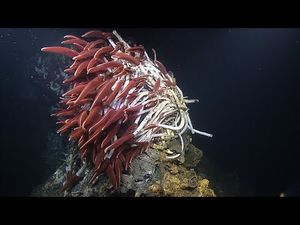
Another worm, Alvinella Pompejana, boasts the record of one of the most thermally resilient macro life forms on the planet, making its home right on the chimney walls. It achieves its thermal miracle with hair like projections that house epsilonproteobacteria who provide insulating, heat resisting services to the worm[10]
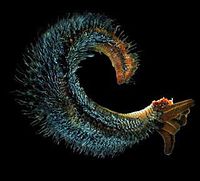
. Finally, one other charismatic example of symbiosis comes from the Yeti Crab. Mobile enough to seek out optimal temperature gradients, these crabs also have hairs along their claws, which they wave around the vents and hydrothermal fluids of the black smokers. This motion helps stir up the rich quantities of methane and hydrogen sulfide solutes, that the chemoautotrophic bacteria then utilize in anaerobic oxidation[11]
.
Black Smokers: A Reflection of the Origin of Life?
Given the resilience of the microbial life found near black smokers, and the relatively early positions of its members on the archaea branch of the phylogenic tree of life [6], some intersection of geologic and biologic study may suggest that the ecology of hydrothermal vents may help unlock the mysteries surrounding the origins of life on earth. The metabolisms of the black smoker microbes, i.e its ability to utilize methane, carbon dioxide, metals, and sulfur all correlate to what study suggests may have been the most readily available reducible compounds, given their origin within the Earth’s mantle as opposed to the atmosphere or even space[12]
. Hydrothermal vents are believed to have emerged almost as soon as liquid water first collected on earth, with examples of fossilized black smokers and correlated evidence of fauna and microfossils at sites estimated to be as old as 3.5 billion years [12]. Essentially, the ability of black smoker communities to thrive under conditions that long predated the metabolic pathways we know support terrestrial and surface ecosystems have unlocked a new potential avenue in learning of the complex interplay between Earth’s geological and biological history.
Key Microbial Players
Amongst the microbes who form the basis of the black smoker biological oasis, one of the most notable members is Methanopyrus kandleri, one of the methanogenic archaea found inside the black smokers themselves. Both hyperthermophilic and halophilic, this methanogen is the most temperature resistant of any other known methanogenic specie. Its genome is so complex and resilient, many have sought to use it in biotech, such as using its unique DNA topoisomerase V to improve DNA sequencing techniques[13]
. Another notable member includes Geoglobus Ahangari, a heterotroph which became the first known thermophilic to be capable of complete oxidation of organic matter to carbon dioxide with Fe(III) oxide reduction or fermentation [6]. Finally, one other key player is the Aciduliprofundum boonei, who thanks to significant global representation in hydrothermal vents (15% of estimated archaea) and its use of iron sulfide is believed to an important biological player in global sulfur and iron budgets [6].
Conclusion
Lacking light and suffering from immense pressure and drastic temperature gradients, Black Smoker hydrothermal vents have still cultivated a diverse and stunning ecosystem thanks to a foundation of extremophiles who can employ specialized proteins and enzymes to metabolize the anoxic inorganic compounds which surge through into the ocean from deep beneath the Earth's surface. Their relative mystery and resilience has brought them enormous attention and study since their discovery in the late 1970s, and further improvement of technique and research may one day reveal that it may be just as important to refer to black smokers as one of the original environments, not just one of the more extreme.
References
- ↑ US Department of Commerce, & National Oceanic and Atmospheric Administration. (2009, February 1). What is a hydrothermal vent? Retrieved from https://oceanservice.noaa.gov/facts/vents.html
- ↑ 2.0 2.1 Gazda, Lyndsy. (2016) The Microbes that Keep Hydrothermal Vents Pumping. Smithsonian Museum, March 2016. https://ocean.si.edu/ecosystems/deep-sea/microbes-keep-hydrothermal-vents-pumping
- ↑ US Department of Commerce, & National Oceanic and Atmospheric Administration. (2008, February 1). What is an extremophile? Retrieved from https://oceanservice.noaa.gov/facts/extremophile.html
- ↑ Martin, William et al (2008). Hydrothermal vents and the origin of life. Nature Review, vol. 6, p. 805-814.
- ↑ 5.0 5.1 5.2 National Geographic Society. (2013, March 7). Deep Sea Hydrothermal Vents. Retrieved from https://www.nationalgeographic.org/media/deep-sea-hydrothermal-vents/
- ↑ 6.00 6.01 6.02 6.03 6.04 6.05 6.06 6.07 6.08 6.09 6.10 Orcutt, Beth N et al (2011). Microbial Ecology of the Dark Ocean above, at, and below the Sea Floor. Microbiology and Molecular Biology Reviews, June 2011, p. 361-422.
- ↑ 7.0 7.1 7.2 7.3 7.4 https://epic.awi.de/id/eprint/35461/1/Jaeschkeetal2012.pdf
- ↑ 8.0 8.1 8.2 https://www.jstor.org/stable/pdf/1696097.pdf?refreqid=excelsior%3A418c3d56193360c32aec198a60a4dedf
- ↑ Pressure in the Deep Seas: AMNH. (n.d.). Retrieved from https://www.amnh.org/learn-teach/curriculum-collections/deep-sea-vents/pressure-in-the-deep-seas
- ↑ www.pnas.orgcgidoi10.1073pnas.0802782105
- ↑ http://www.bbc.com/earth/story/20170412-in-the-deep-sea-there-live-crabs-that-look-like-yetis
- ↑ 12.0 12.1 Martin, William et al (2008). Hydrothermal vents and the origin of life. Nature Review, vol. 6, p. 805-814.
- ↑ https://microbewiki.kenyon.edu/index.php/Methanopyrus_kandleri
Authored for Earth 373 Microbial Ecology, taught by Magdalena Osburn, 2020, NU Earth Page.
